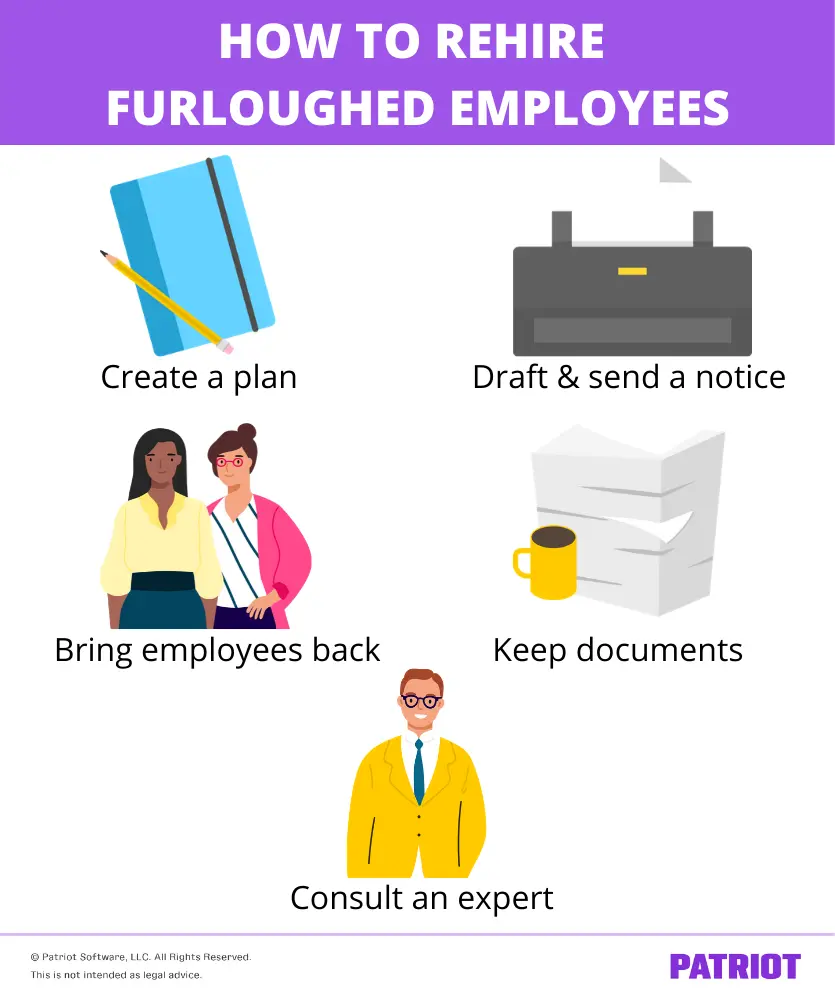You furloughed your employees, and now you want to bring them back. Do you know how to rehire furloughed employees?
Like hiring workers for the first time, rehiring furloughed employees requires careful thought and consideration, some paperwork footwork, and detailed recordkeeping.
How to rehire furloughed employees
Whether you are bringing back furloughed employees for PPP loan forgiveness or are simply ready for more hands on deck, you need to know how to rehire furloughed employees.

1. Create a plan
First things first: you need to create a return-to-work plan outlining new procedures, staff members, and employee responsibilities. If you’re bringing furloughed employees back during COVID-19, you likely have new sanitation guidelines all employees must adhere to.
You may not be able to end the furlough immediately for all your workers. So, you must figure out which furloughed employees you are able to bring back. You might adapt your company’s budget to verify you can afford to bring back workers.
2. Draft your return from furlough notice
Create a written return from furlough notice and send it to the worker. That way, you have a paper trail showing that you sent the notice (as well as when you sent it).
Give the employee plenty of time when sending your return from furlough notice. Don’t send the notice the day before you expect the employee to return to work.
Include ample information in the notice so the employee knows what they’re agreeing to if they come back to work.
Your return from furlough notice should include things like:
- Employment offer
- Return-to-work date
- Changes in job duties
- Employment status (e.g., hours)
- Pay and benefits information
- New procedures (e.g., COVID-19 safety procedures)
- Employee deadline to respond to the letter
3. Bring employees back
The furloughed employee is not required to accept your rehire offer. They may have found another job. Or, maybe they don’t want to come back to work.
But if a furloughed employee does accept your offer to return from furlough, you can bring them back.
Provide information on job responsibilities, especially if they’ve changed since the employee was furloughed. Conduct background checks, if applicable. And, add the employee back on payroll.
Generally, furloughed employees remain on employer-sponsored health plans, unlike laid-off workers whose COBRA coverage might kick in. But if you removed the furloughed employee from company-sponsored benefits, distribute paperwork and reinstate them as appropriate.
4. Keep documents in your records
Whenever you do something employee-related, you need to keep detailed records, especially when hiring or terminating employees.
Depending on how long the employee has been furloughed, you may need to brush up some of your original onboarding paperwork (e.g., background check). And if you make any changes to the employee’s pay rate, pay frequency, or employment status (e.g., full-time vs. part-time employment), you need to record it.
If you’re bringing back furloughed employees in response to receiving a PPP loan, keep documents detailing things like:
- A copy of the return from furlough notice
- When you sent the return from furlough notice
- The employee’s response to your rehire offer (i.e., whether they accepted or declined)
- What day the employee resumed work
- Pay-related information
5. Consult an expert
Situations may differ. Your state might set different rules for rehiring furloughed employees based on how long they were furloughed for.
For example, depending on how long the employee was furloughed, you may need to:
- Update or complete a new Form I-9
- Conduct a background check or drug test
If you have questions about how to rehire furloughed employees, it’s better to be safe than sorry. Consult your state or a small business lawyer for more information on compliance.
Are you bringing back your furloughed employees? Make sure payroll goes off without a hitch. Join the tens of thousands of business owners who trust Patriot’s online payroll to streamline the process. Start your free trial now!
This is not intended as legal advice; for more information, please click here.


